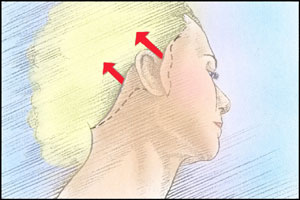Facelift Jacksonville Fl by Dr. Duffy
Welcome to Jacksonville Plastic Surgery by Duffy’s guide to the Facelift Procedure. This information about the procedure explains topics that will bring about a fully satisfying result with your surgery. Your private consultation with Dr. Duffy can best answer any questions you have about specific concerns about your Facelift in Jacksonville or Ponte Vedra.
In time, gravity, sun exposure and the stresses of daily life take their toll on our faces and necks. Deep creases appear beside the mouth, the jaw line slackens and becomes jowly and the neck develops loose folds and fat deposits. Facelifts counteract these signs of aging by tightening muscle, removing fat and trimming excess skin, giving your face a fresher, youthful look. After surgery, some patients look 10-15 years younger.
Facelifts rejuvenate the mid- to lower face and neck and are effective in correcting such conditions as: midface sagging, deep creases under the eyes and between the nose and mouth, jowls due to loss of muscle tone, sagging areas of fat and loose skin and fat under the chin and jaw.
Stitches and surgical clips are removed within a week of surgery, but the entire recovery time, including time for swelling and the stiffness of facial muscles to come down is usually 3-6 weeks. Sensation typically returns to normal within a few months and scars will become less red, raised, lumpy or itchy over time.
Many patients return to work in 10 days to 2 weeks. Camouflage cosmetics can be used to minimize the appearance of bruising.
Am I a good candidate for facelift surgery?
The face usually portrays the first visible signs of aging. Both gravity and diminished volume result in the facial features of aging. Most patients requesting evaluation for facelift feel that their facial features do not reflect their youthful spirit and energy level. They are looking for ways to refresh and rejuvenate their appearance. There are many different variations of the facelift procedure that smooth the skin of the face and neck, tighten the underlying tissues and muscle, and remove excess skin. Ultimately, the facelift will allow you to turn back the hands of time to better reflect your youthful spirit.
How will D. Duffy evaluate me for a facelift?
During the pre-operative consultation, Dr. Duffy will perform a history and physical examination. During your physical examination, your facial bone structure, underlying skin structure, skin thickness, texture, and elasticity as well as the extent of facial wrinkles and folds will be assessed. This information will be used to formulate a surgical plan and the goals of the procedure will be discussed. Generally, a facelift is a very versatile procedure, and Dr. Duffy will explain the technique that he feels most comfortable with and that offers the lowest risk. Dr. Duffy will select the surgical technique that he or she feels will obtain the best outcome for you based on your discussions regarding the outcome you wish to achieve.
How is a facelift performed?
The facelift procedure continues to evolve. Over the years, the procedure has changed from simple skin lifting to more complex deeper plane lifting techniques. Today, many different techniques exist, with outcomes that are consistently reliable and durable. The facelift procedure usually involves incisions in front of and behind the ear. The incisions may extend into the scalp. Once the incisions are made, various degrees of undermining of the skin are performed, and the deeper layers of the face are ‘lifted’. Muscle tightening as well as liposuction of the neck and jowls may be performed, and excess skin is either removed or repositioned. The results are a reversal of the effects of gravity and tightening of soft tissues of the face to restore a more youthful contour to the face.
Your Surgical Experience
The goal of Dr. Duffy is to make your surgical experience as easy and as comfortable as possible.
Pre-Operative
If you are a smoker, you will be asked to stop smoking well in advance of the surgery. Certain medications that increase the risk of bleeding such as Aspirin, non-steroidal anti-inflammatory medications, and some vitamins/homeopathic regimens should be discontinued prior to surgery. If your hair is short, you may want it to grow out enough to cover your incisions while they heal. Any chemical processing of your hair should be performed prior to surgery since you cannot have any of these procedures for a month of more after surgery. If your facelift will be performed on an outpatient basis, be sure to arrange for someone to drive you home and stay with you for at least the first night following surgery.
Day of Surgery
Medications are administered for your comfort during the procedure. You and your plastic surgeon will have decided in advance what type of anesthesia is to be used – either intravenous sedation (twilight) or general anesthesia. For your safety during and after the operation, various monitors are used to check your heart, blood pressure, pulse and the amount of oxygen circulating in your blood.
When surgery is completed, you will be taken into a recovery area. A bandage may be wrapped around your face. Sometimes small tubes will be inserted beneath the skin to drain away fluid that might otherwise accumulate. There is surprisingly very little discomfort experienced after facelift surgery. However, any discomfort you may experience will be controlled with pain medication as needed.
You may be permitted to go home after a few hours, although some patients may stay overnight in a hospital or surgical facility.
Recovery
It is important to realize that the amount of time it takes to recover from Facelift surgery varies greatly between individuals. Elevation of the head is extremely helpful in reducing the initial post-operative swelling. Your surgeon may also advise you to use ice packs intermittently.
You should avoid Aspirin and non-steroidal anti-inflammatory medications for the first few days after your surgery. Smoking and exposure to second-hand smoke should be avoided to prevent delays in the healing process.
Once the dressings and drains are removed, puffiness and discoloration may be more pronounced in some portions of the face than others. Do not be alarmed by any unevenness or temporary asymmetry – this is normal. Most swelling is usually noted in the first 24 to 48 hours, and most bruising resolves within 2 weeks. Concealing makeup is usually permitted after the first week. You may experience numbness to the face post-operatively, which usually resolves within several months.
Some patients find that mild swelling persists for many weeks. Most stitches are removed within a week of the surgery.
Straining, bending, and lifting should be avoided during the early post-operative period as these activities may predispose you to bleeding.
Dr. Duffy will give you specific instructions that may include caring for the dressings and incisions, directions for your analgesics and other medications, specific concerns to look for, and when to follow up in the office to monitor your healing process. It may take several months for the swelling to fully resolve, and up to 6 months for the incision scars to fully fade. Avoidance of factors that could reduce the benefits of the surgery, such as excessive unprotected sun exposure and cigarette use, is vital.
 Results of Your Facelift
Results of Your Facelift
The results of your facelift may be subtle or dramatic, depending on your appearance prior to the surgery as well as the specific goals that you and your plastic surgeon have established. Since the healing process is gradual, you should expect to wait several weeks for an accurate picture of your “new look”. Additional minor changes or settling may occur over several months following your Facelift surgery.
You will return to Dr. Duffy’s office for follow up observation at prescribed intervals, at which time your progress will be evaluated.
Other Resources for Facelift Jacksonville Fl:
American Society of Plastic Surgeons
AAFPRS.ORG
Medicine.net
Wikipedia




 Results of Your Facelift
Results of Your Facelift